In living Memory
Olympia McEwan curator of the book
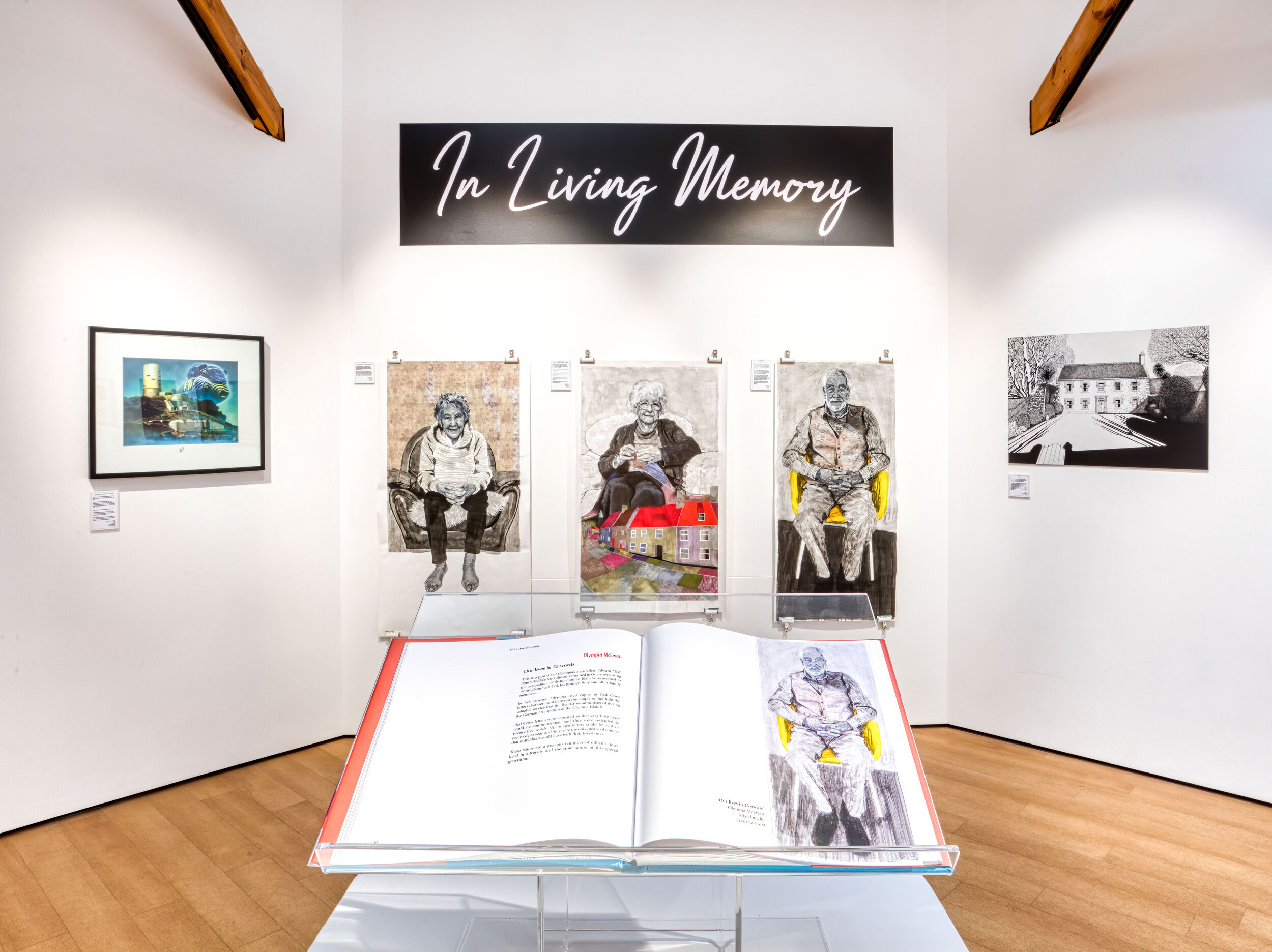
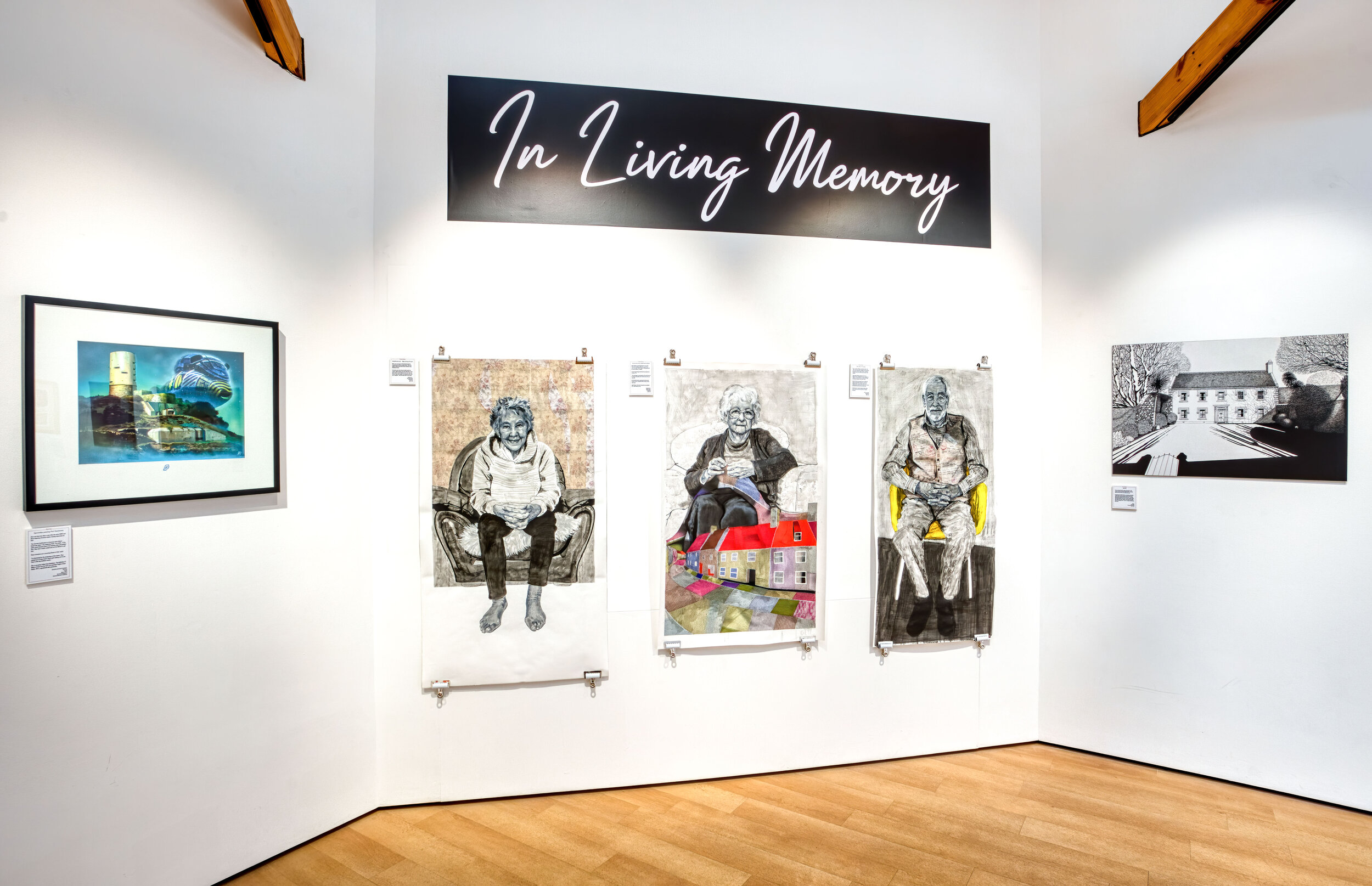
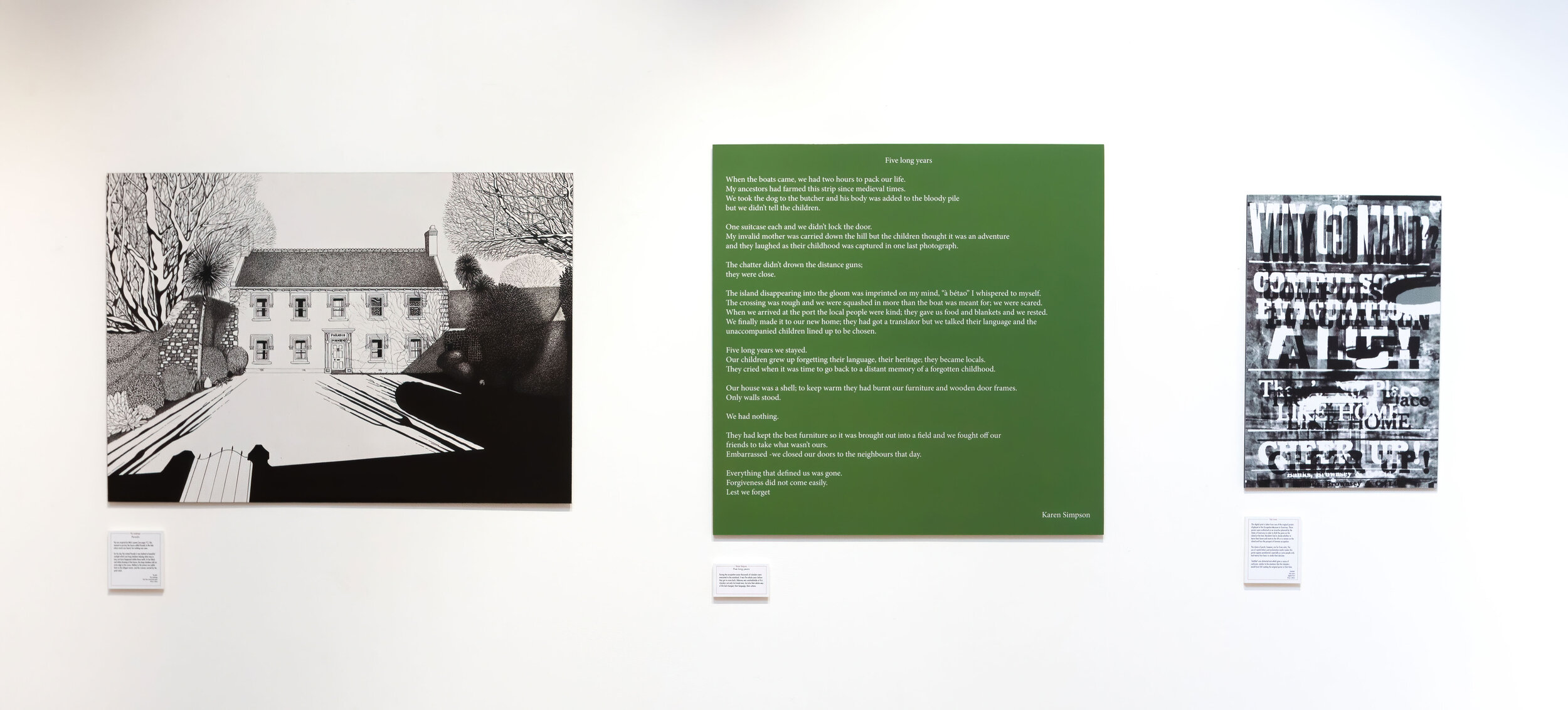
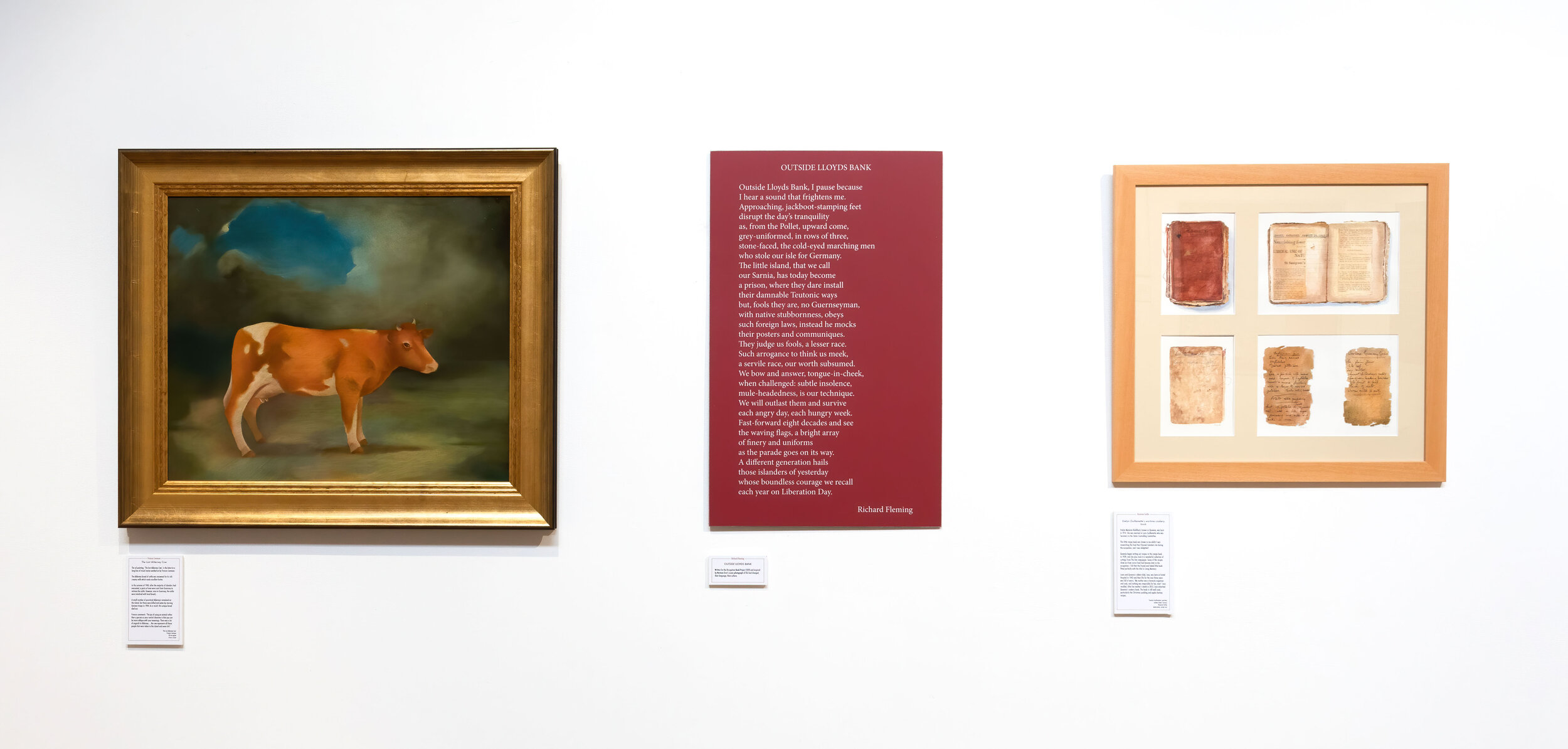
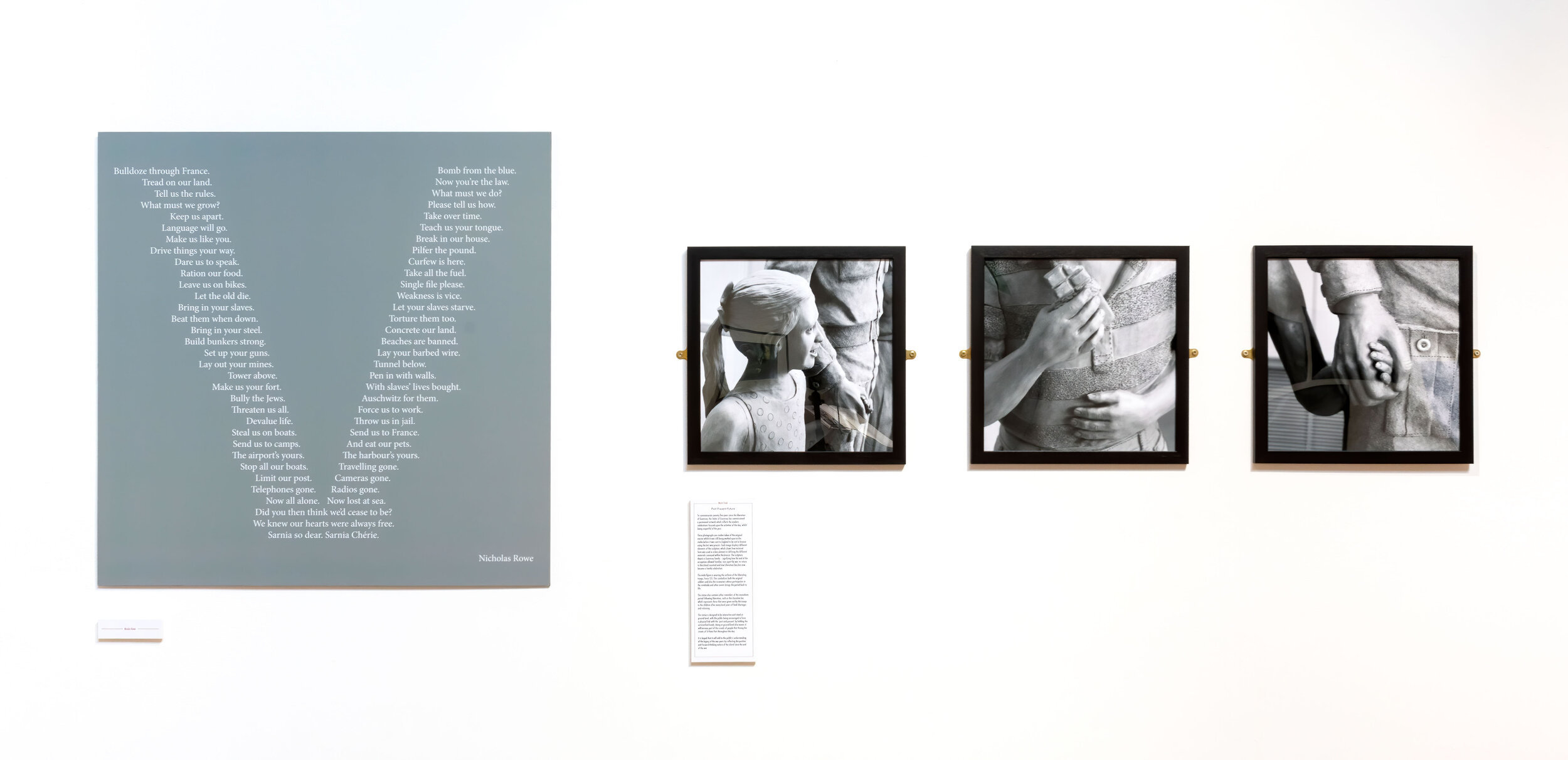
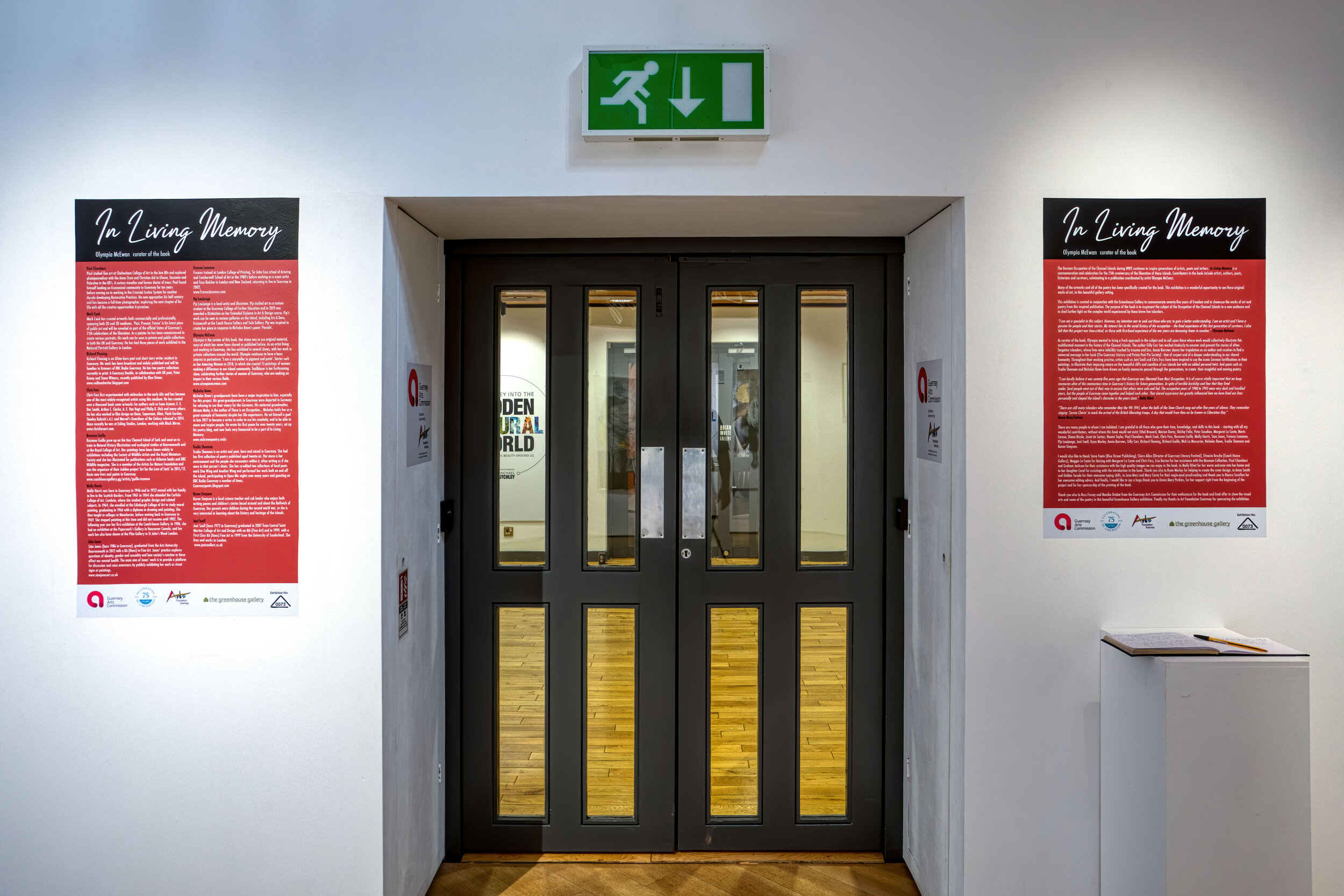
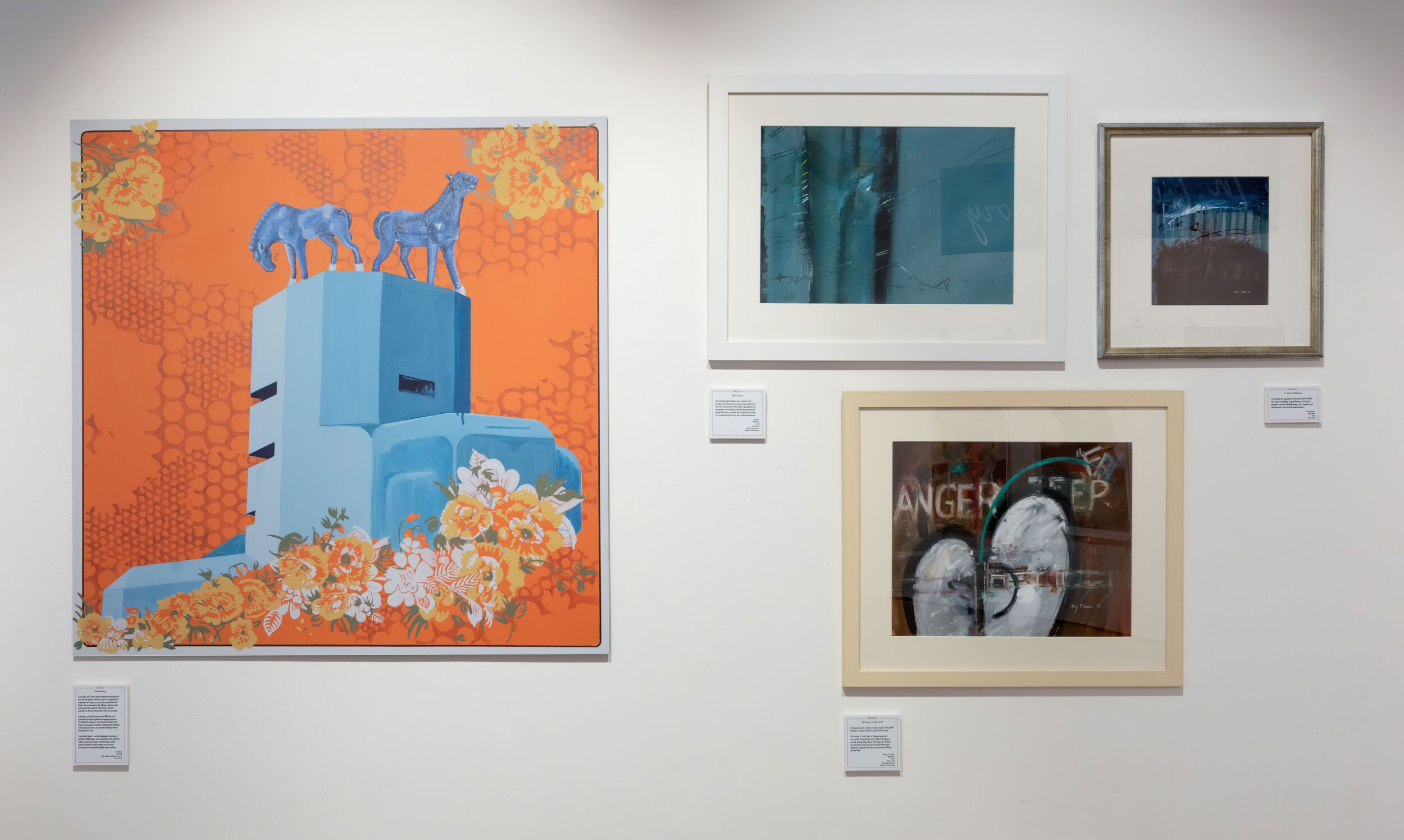
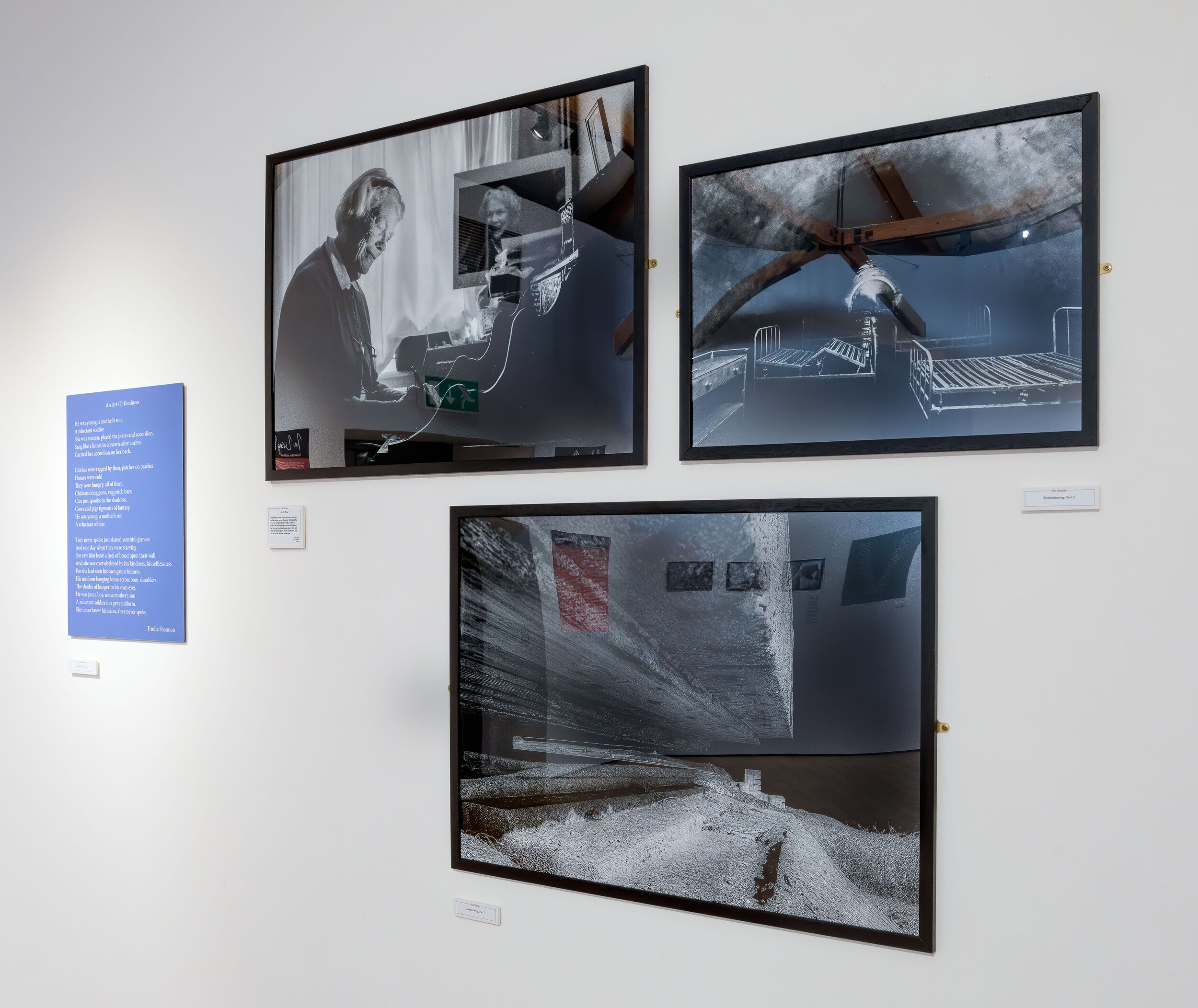
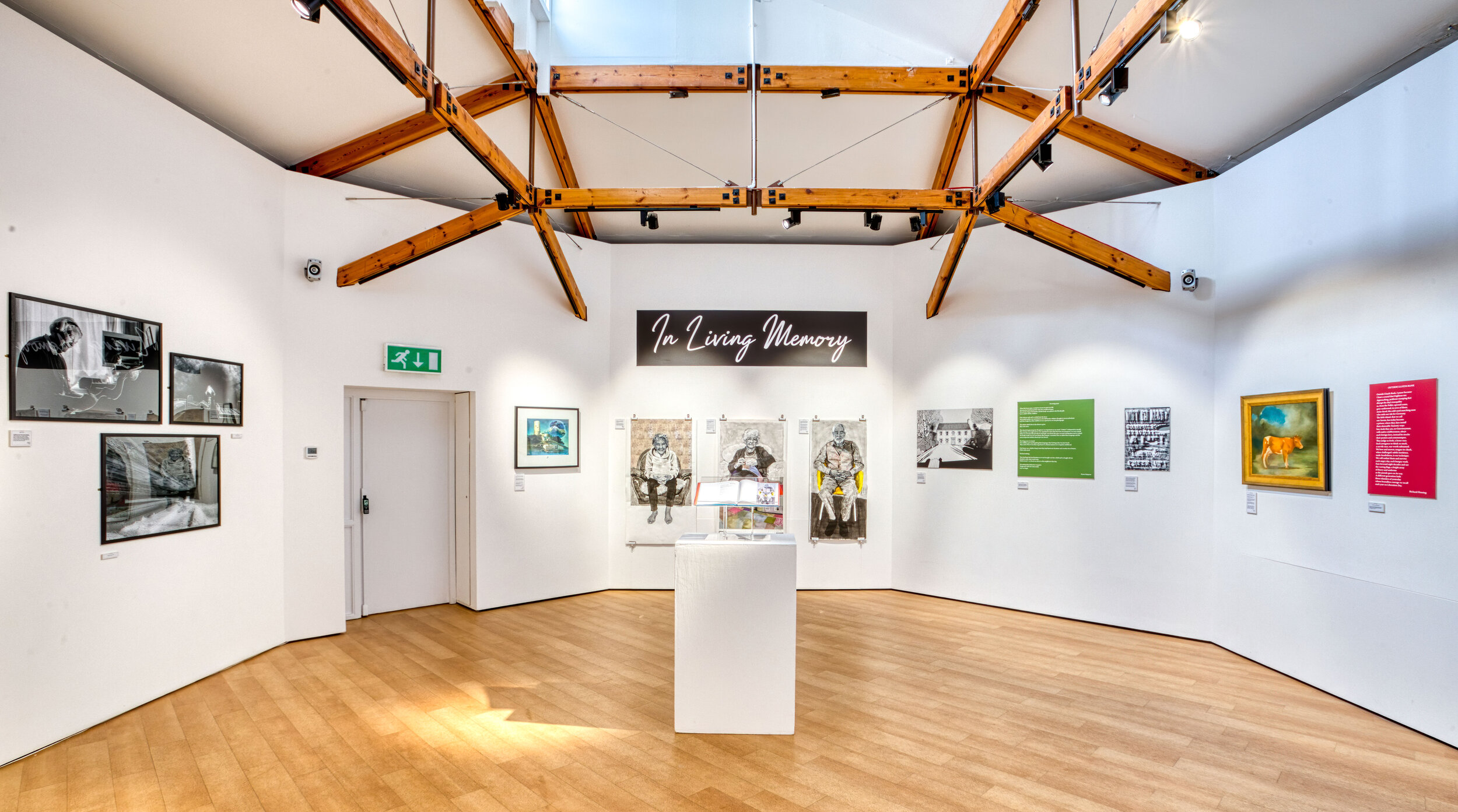
Exhibition Text
The German Occupation of the Channel Islands during WW2 continues to inspire generations of artists, poets and writers. In Living Memory is a commemoration and celebration for the 75th anniversary of the liberation of these islands. Contributors to the book include artists, authors, poets, historians and survivors, culminating in a publication coordinated by artist Olympia McEwan.
Many of the artworks and all of the poetry has been specifically created for the book. This exhibition is a wonderful opportunity to see these original works of art, in this beautiful gallery setting.
This exhibition is curated in conjunction with the Greenhouse Gallery to commemorate seventy-five years of freedom and to showcase the works of art and poetry from this inspired publication. The purpose of the book is to re-present the subject of the Occupation of the Channel Islands to a new audience and to shed further light on the complex world experienced by these brave few islanders.
“I am not a specialist in this subject. However, my intention was to seek out those who are; to gain a better understanding. I am an artist and I have a passion for people and their stories. My interest lies in the social history of the occupation – the lived experience of this last generation of survivors. I also felt that this project was time-critical, as those with first-hand experience of the war years are becoming fewer in number.” Olympia McEwan
As curator of the book, Olympia wanted to bring a fresh approach to the subject and to call upon those whose work would collectively illustrate this multifaceted moment in the history of the Channel Islands. The author Gilly Carr has worked tirelessly to uncover and present the stories of often forgotten islanders, whose lives were indelibly touched by trauma and loss. Annie Barrows shares her trepidation as an author and resolves to find a universal message in her book (The Guernsey Literary and Potato Peel Pie Society) - that of respect and of a deeper understanding in our shared humanity. Throughout their working practise, artists such as Jeni Snell and Chris Foss have been inspired to use the iconic German fortifications in theirpaintings, to illustrate their imposing nature on the beautiful cliffs and coastline of our islands but with an added personal twist. And poets such as Trudie Shannon and Nicholas Rowe have drawn on family memories passed through the generations, to create their insightful and moving poetry.
“I can hardly believe it was seventy-five years ago that Guernsey was liberated from Nazi Occupation. It is of course vitally important that we keep memories alive of this momentous time in Guernsey’s history for future generations. In spite of terrible hardship and fear that they lived
under, local people went out of their way to ensure that others were safe and fed. The occupation years of 1940 to 1945 were very dark and troubled years, but the people of Guernsey came together and helped each other. That shared experience has greatly influenced how we have lived our lives personally and shaped the island’s character in the years since.” Molly Bihet
“There are still many islanders who remember May the 9th 1945, when the bells of the Town Church rang out after five years of silence. They remember singing ‘Sarnia Chérie’ to mark the arrival of the British liberating troops. A day that would from then on be known as Liberation Day.”
Dame Mary Perkins
There are many people to whom I am indebted. I am grateful to all those who gave their time, knowledge, and skills to this book – starting with all my wonderful contributors, without whom this book would not exist; Ethel Brouard, Marion Dorey, Shirley Falla, Peter Gaudion, Margaret Le Conte, Mavis Lemon, Diana Nicole, Janet de Santos, Naomi Taylor, Paul Chambers, Mark Cook, Chris Foss, Rosanne Guille, Molly Harris, Sian Jones, Frances Lemmon, Pip Looijenga, Jeni Snell, Ryan Morley, Annie Barrows, Gilly Carr, Richard Fleming, Richard Guille, Nick Le Messurier, Nicholas Rowe, Trudie Shannon and Karen Simpson.
I would also like to thank Steve Foote (Blue Ormer Publishing), Claire Allen (Director of Guernsey Literary Festival), Elmarie Brache (Coach House Gallery), Maggie Le Conte for liaising with Margaret Le Conte and Chris Foss, Lisa Burton for her assistance with the Museum Collection, Paul Chambers and Graham Jackson for their assistance with the high quality images we can enjoy in the book, to Molly Bihet for her warm welcome into her home and to her daughter Carol for assisting with the introduction to the book. Thank you also to Ryan Morley for helping to create the cover design, to Anna Smithand Debbie Torode for their awesome typing skills, to Jane Moss and Mary Carey for their eagle-eyed proofreading and thank you to Bianca Sarafian for her awesome editing advice. And finally, I would like to say a huge thank you to Dame Mary Perkins, for her support right from the beginning of the project and for her sponsorship of the printing of the book.
Thank you also to Russ Fossey and Monika Drabot from the Guernsey Arts Commission for their enthusiasm for the book and kind offer to show the visual arts and some of the poetry in this beautiful Greenhouse Gallery exhibition. Finally my thanks to Art Foundation Guernsey for sponsoring the exhibition.
Exhibiting Artists and artwork
Jeni Snell
‘Screaming’ Jeni Snell acrylic and household paint on canvas 97cm x 97cm
Screaming
Jeni Snell’s art is based on the ongoing relationship she has with the place in which she grew up. Exploring her experience of living in a previously-occupied Channel Island, she is interested in the influence that our early environment has upon the formation of identity, especially in the LGBTIQA context, which she occupies.
Attending a school built on top of a WW2 German gun battery brought together the opposing dynamics of ‘childhood innocence’ and ‘the architecture of war’ within the playground and this conflicting and troubling relationship has been a consistently-developed theme throughout her work.
Using found objects, Jeni pays homage to Guernsey’s significant WW2 legacy. She contextualises the islanders’ make-do-and-mend creative resourcefulness whilst under occupation. A stark contrast to our current throwaway and materialistic global society malaise.
Jeni Snell
Jeni Snell (born 1972 in Guernsey) graduated in 2007 from Central Saint Martins College of Art and Design with an MA (Fine Art) and in 1999, with a First Class BA (Hons) Fine Art in 1999 from the University of Sunderland. She lives and works in London.
Molly Harris
‘Writing on the Wall’
Acrylic : 35cm x 43cm
(By kind permission of Rodney & Elmarie Brache)
Writing on the Wall
In this painting the artist has employed part of the graffiti found on an interior wall of a German-built bunker. The missing ‘D’ and ‘clear’ of ‘Danger keep clear’ was entirely unintentional, but resulted in the phrase artwork reading ‘Anger keep’. This depicts the feelings of a devastated community in a despoiled landscape, which was originally painted on a tiny portion of Hitler’s Atlantic Wall.
‘Coastal Defence’
Acrylic : 22cm x 20cm
Coastal Defence
For centuries the population of Guernsey had to defend their island by building Coastal Defences. To this day examples remain of Martello towers, forts, bunkers, gun emplacements and anti-tank beach defences.
‘Coastal Defence’
Acrylic : 22cm x 20cm
Coastal Defence
For centuries the population of Guernsey had to defend their island by building Coastal Defences. To this day examples remain of Martello towers, forts, bunkers, gun emplacements and anti-tank beach defences.
Molly Harris
Molly Harris was born in Guernsey in 1946 and in 1952 moved with her family to live in the Scottish Borders. From 1961 to 1964 she attended the Carlisle College of Art, Cumbria, where she studied graphic design and related subjects. In 1964, she enrolled at the Edinburgh College of Art to study mural painting, graduating in 1966 with a diploma in drawing and painting. She then taught in colleges in Manchester, before moving back to Guernsey in 1969. She stopped painting at this time and did not resume until 1982. The following year saw her first exhibition at the Coach-house Gallery. In 1986, she had an exhibition at the Paperwork’s Gallery in Vancouver Canada, and her work has also been shown at the Pike Gallery in St John’s Wood London.
Trudie Shannon
Trudie Shannon
Trudie Shannon is an artist and poet, born and raised in Guernsey. She had her first collection of poetry published aged twenty-six. Her muse is her environment and the people she encounters within it, often writing as if she were in that person’s shoes. She has co-edited two collections of local poets work One Wing and Another Wing and performed her work both on and off the island, participating in Open Mic nights over many years and guesting on BBC Radio Guernsey a number of times.
Paul Chambers
Molly Bihet
Storytelling has earned its place as the most important tradition humans possess. The reason for this being that every story contains a lesson to guide its audience. Molly is our narrative; our best voice of the Occupation. Her stories not only frame her experience of those dark years; they also teach us to love, to forgive others, to be just and to strive for better than we have.
Paul Chambers
Paul studied fine art at Cheltenham College of Art in the late 80s and explored photojournalism with the Amos Trust and Christian Aid in Ghana, Tanzania and Palestine in the 00’s. A curious traveller and former doctor of trees; Paul found himself leading an Ecumenical community in Guernsey for ten years before moving on to working in the Criminal Justice System for another decade developing Restorative Practices. He now approaches his half century and has become a full-time photographer, exploring the next chapter of his life with all the creative opportunities it promises.
Chris Foss
Spaceship passing Fort Saumarez
Chris was born less than a year after the end of WW2 and these imposing structures made a lasting impression on him: ‘The German fortifications in Guernsey were almost brand new when I was exploring them,’ he recalls. ‘I’d be quite scared because there’d be warning signs and barbed wire. They were crudely sealed and not too difficult to get into.’ These structures are a recurring theme in Chris’ work:
‘I’m fascinated by the proportions of the towers. They remind me of huge Easter Island gods looking out to sea. They’re like big toothless masks.’ This is an extract taken from Hardware : The Definitive SF Works of Chris Foss by Chris Foss and Rian Hughes (Titan Books, 2011), reproduced with permission.
Chris Foss
Chris Foss first experimented with airbrushes in the early 60s and has become one of the most widely-recognised artists using this medium. He has created over a thousand book cover artworks for authors such as Isaac Asimov, E. E. Doc Smith, Arthur C. Clarke, A. E. Van Vogt and Philip K. Dick and many others. He has also worked in film design on Dune, Superman, Alien, Flash Gordon, Stanley Kubrick’s A.I. and Marvel’s Guardians of the Galaxy released in 2014. More recently he was at Ealing Studios, London, working with Black Mirror.
Olympia McEwan
‘Barefoot but we ... keep smiling through’
Mixed media 133cm x 75cm
Barefoot but we ... keep smiling through
Mavis Lemon was born in Sark and lived through the occupation years with her extended family. They had to make do with what they had and she remembers being barefooted at times. She and her sister were dressed in clothes made from curtains. If Mavis wanted to go to the weekly dance, she’d have to borrow a pair of shoes from her aunt. Times were hard, but they drew strength from knowing that they were all in it together – and were always there for each other.
‘Our lives in 25 words’
Mixed media 127cm x 61cm
Barefoot but we ... keep smiling through
Mavis Lemon was born in Sark and lived through the occupation years with her extended family. They had to make do with what they had and she remembers being barefooted at times. She and her sister were dressed in clothes made from curtains. If Mavis wanted to go to the weekly dance, she’d have to borrow a pair of shoes from her aunt. Times were hard, but they drew strength from knowing that they were all in it together – and were always there for each other.
‘Homecomer story, dedicated to Beda’
Mixed media 113cm x 75cm
Homecomer story, dedicated to Beda
Beda Thompson’s portrait represents the story of the Homecomers of Alderney. Beda, her sister and their mother and father, fled the island in 1940 along with all but seven of Alderney’s residents. She had mixed feelings about their Homecoming Day in December 1945: ‘I was very happy to come home but sad to see the state of the island. Some people saw it, turned around and never came back.’ But she and her parents’ generation were determined to stay, in order to rebuild their lives and their precious island home. Beda Thompson died before the portrait was completed, so it is now dedicated to her.
Olympia McEwan
Olympia is the curator of this book. Her vision was to use original material, most of which has never been shared or published before. As an artist living and working in Guernsey, she has exhibited in several shows, with her work in private collections around the world. Olympia continues to have a keen interest in portraiture: ‘I am a storyteller in pigment and paint’. Stories such as her Amazing Women in 2018, in which she created 15 paintings of women making a difference in our island community. Trailblazer is her forthcoming show, celebrating further stories of women of Guernsey, who are making an impact in their various fields.
Pip Looijenga
‘Paradis’
Fine liner and acrylic paint 59cm x 42cm
Paradis
Pip was inspired by Nick’s poem [see page 71]. She wanted to portray the house called Paradis in the Vale where much was heard, but nothing was seen. On the day Pip visited Paradis it was bathed in beautiful sunlight which cast long shadows belying what may or may not have happened within those walls. In her black and white drawing of the house, the deep shadows add an eerie edge to the scene. Hidden in the picture are subtle hints to the alleged events, and the screams carried by the quiet wind.
Pip Looijenga
Pip Looijenga is a local artist and illustrator. Pip studied art as a mature student at the Guernsey College of Further Education and in 2019 was awarded a Distinction on her Extended Diploma in Art & Design course. Pip’s work can be seen in various galleries on the island, including Iris & Dora, Framecraft at the Coach House Gallery and Sula Gallery. Pip was inspired to create her piece in response to Nicholas Rowe’s poem ‘Paradis’.
Karen Simpson
Karen Simpson
Karen Simpson is a local science teacher and cub leader who enjoys both writing poems and children’s stories based around and about the Bailiwick of Guernsey. Her parents were children during the second world war, so she is very interested in learning about the history and heritage of the islands.
Siân Jones
‘Untitled’
This digital print is taken from one of the original posters displayed at the Occupation Museum in Guernsey. These posters were authorised as an incentive planned by the States of Guernsey in order to distil the panic on the island at the time. Residents had to decide whether to leave their home and move to the UK or to remain on the island and face the prospect of German occupation. The choice of words, however, are far from calm. The use of capital letters and exclamation marks makes this poster appear paradoxical, especially as some people only had twenty-four hours to make their decision. ‘Untitled’ uses distorted text which gives a sense of confusion, similar to the emotions that the islanders would have felt reading the original poster at that time.
Siân Jones
Siân Jones (born 1986 in Guernsey), graduated from the Arts University Bournemouth in 2012 with a BA (Hons) in Fine Art. Jones’ practice explores questions of identity, gender and sexuality and how society’s reaction to these affect our mental health. The main aim of Jones’ work is to provide a platform for discussion and raise awareness by publicly exhibiting her work as street signs or paintings.
Frances Lemmon
The Last Alderney Cow
The oil painting, ‘The last Alderney Cow’, is the latest in a long line of visual stories worked on by Frances Lemmon. The Alderney breed of cattle was renowned for its rich creamy milk which made excellent butter. In the summer of 1940, after the majority of islanders had evacuated, a party of men were sent from Guernsey to retrieve the cattle. However, once in Guernsey, the cattle were interbred with local breeds. A small number of pure-bred Alderneys remained on the island, but these were killed and eaten by starving German troops in 1944. As a result, this unique breed died out. Frances comments: ‘The joy of using an animal rather than a person as your central character is that you can be more oblique with your meanings. There was a lot of anguish in Alderney ... the cow represents all those people that were taken to the island and never left.’
Frances Lemmon
Frances trained at London College of Printing, Sir John Cass school of drawing and Camberwell School of Art in the 1980’s before working as a scenic artist and faux finisher in London and New Zealand, returning to live in Guernsey in 2002.
Richard Fleming
OUTSIDE LLOYDS BANK
Written for the Occupation Book Project 2020 and inspired by Norman Grut’s iconic photograph of life had changed, their language, their culture.
Richard Fleming
Richard Fleming is an Ulster-born poet and short story writer resident in Guernsey. His work has been broadcast and widely published and will be familiar to listeners of BBC Radio Guernsey. He has two poetry collections currently in print: A Guernsey Double, in collaboration with UK poet, Peter Kenny and Stone Witness, recently published by Blue Ormer.
Rosanne Guille
Evelyn Guillemette’s wartime cookery book
Evelyn Marjorie Robilliard, known as Queenie, was born in 1914. She was married to Louis Guillemette who was Secretary to the States Controlling Committee. This little recipe book was shown to me whilst I was researching the food that Channel Islanders ate during the occupation, and I was delighted! Queenie began writing out recipes in this recipe book in 1939, and she also stuck in a wonderful collection of cuttings from The Star newspaper. Some of the recipes show just how scarce food had become later in the occupation. I felt that the frayed and faded little book fitted perfectly with the title In Living Memory. Louis and Queenie’s eldest child, José, was born at Castel Hospital in 1942 and their life for the next three years was full of worry. ‘My mother was a fantastic organiser and cook, and nothing was impossible for her, ever!’ José recalled. After her mother’s death in 2012, José inherited Queenie’s cookery book. The book is still well used, particularly the Christmas pudding and apple chutney recipes.
Rosanne Guille
Rosanne Guille grew up on the tiny Channel Island of Sark and went on to train in Natural History Illustration and ecological studies at Bournemouth and at the Royal College of Art. Her paintings have been shown widely in exhibitions including the Society of Wildlife Artists and the Royal Miniature Society and she has illustrated for publications such as Usborne books and BBC Wildlife magazine. She is a member of the Artists for Nature Foundation and was the organizer of their Jubilee project ‘Art for the Love of Sark’ in 2011/12. Rosie now lives and paints in Guernsey.
Nicholas Rowe
Nicholas Rowe
Nicholas Rowe’s grandparents have been a major inspiration to him, especially for this project. His great-grandparents in Guernsey were deported to Germany for refusing to run their vinery for the Germans. His maternal grandmother, Miriam Mahy, is the author of There is an Occupation... Nicholas holds her as a great example of humanity despite her life experiences. He set himself a goal in late 2017 to become a writer in order to use his creativity, and to be able to move and inspire people. He wrote his first poem for over twenty years, set up his poetry blog, and now feels very honoured to be a part of In Living Memory.
Mark Cook
Past Present Future
To commemorate seventy-five years since the liberation of Guernsey, the States of Guernsey has commissioned a permanent artwork which reflects the modern celebrations focused upon the activities of the day, whilst being respectful of the past. These photographs are studies taken of the original master whilst it was still being worked upon in the studio before it was sent to England to be cast in bronze using the lost wax process. Each image displays different elements of the sculpture, which shows how textured form was used as a key element in defining the different materials conveyed within the bronze. The sculpture depicts a Guernsey family – signifying how the end of the occupation allowed families, torn apart by war, to return to the island reunited and how Liberation Day has now become a family celebration. The male figure is wearing the uniform of the liberating troops, Force 135. This symbolizes both the original soldiers and also the re-enactors whose participation in the cavalcade and other events brings the period back to life. The statue also contains other reminders of the immediate period following liberation, such as the chocolate bar, which represents those that were given out by the troops to the children after many hard years of food shortages and rationing. The statue is designed to be interactive and stand at ground level, with the public being encouraged to form a physical link with the ‘past and present’ by holding the outstretched hands. Being at ground level also means it will become part of the crowds of people that throng the streets of St Peter Port throughout the day. It is hoped that it will add to the public’s understanding of the legacy of the war years by reflecting the positive and forward-thinking nature of the island since the end of the war.
Mark Cook
Mark Cook has created artworks both commercially and professionally, spanning both 2D and 3D mediums. ‘Past, Present, Future’ is his latest piece of public art and will be unveiled as part of the official States of Guernsey’s 75th celebrations of the liberation. As a painter he has been commissioned to create various portraits. His work can be seen in private and public collections in both the UK and Guernsey. He has had three pieces of work exhibited in the National Portrait Gallery in London.




















